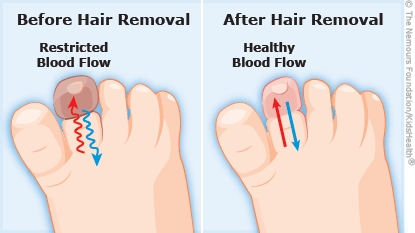After Hair Tourniquet Removal: Caring for Your Child
Hair tourniquets are rare and usually don't cause any lasting problems when removed quickly.


A hair tourniquet happens when one or more strands of hair wrap tightly around a child's body part — usually a toe, but it also can happen to a finger or the genitals (the penis in boys or the clitoris or labia in girls). The wrapped hair can block blood flow, causing pain and swelling past where the hair is wrapped.
This usually happens in babies when hair falls from the mother or a caretaker. This is especially a problem a few months after delivery when some moms experience a period of hair loss. When the baby's hands and feet wiggle in mittens, socks, or footed pajamas, a hair can wrap around the fingers or toes; thread from mittens and socks can cause the same problem. Hair can fall into the diaper area during diaper changes and get wrapped around the genitals when the baby moves around.
A hair or thread tourniquet sometimes happens in older children, as well, but less often than in babies.
The health care provider removed your child's hair or thread tourniquet, probably using special tools and a magnifying glass. Your child might have had a local numbing medicine to ease pain during the procedure.
After the hair or thread was removed, the wound was rinsed thoroughly with water or saline (saltwater). The health care provider examined the area to make sure that blood was flowing to it. To prevent infection the health care provider may have given you an antibiotic for your child, either as an ointment to be applied to the wound or as a medication to be given by mouth. If needed, your child was given a tetanus shot. Proper care at home will help prevent infection.

-
Follow your health care provider's instructions for cleaning the wound.
-
If you were given an antibiotic skin ointment, apply it as instructed.
-
If your child is uncomfortable, a medication may help:
-
For children under 6 months, you may give acetaminophen.
-
For children over 6 months, you may give acetaminophen OR ibuprofen, if recommended by your health care provider.
-
For the next 24 hours, keep the area raised as much as possible to help reduce swelling. You might try propping the area up on your arm or chest while you hold your child. Avoid propping your child with pillows as this can be dangerous for a sleeping baby.

-
A follow-up appointment 24–48 hours after the tourniquet removal is usually recommended to see how the area is healing. Be sure to keep all follow-up appointments.
-
Check your child's fingers and toes daily to make sure no hair is tangled again.

-
You have questions about how to take care of your child's wound at home.
-
Your child has continued pain.
-
Your child has a fever.
-
Your baby is irritable or cries a lot.

-
The area past where the hair tourniquet was removed is pale or cold.
-
The wound is bleeding.
-
The area around the wound seems infected; signs include redness, swelling, or draining pus.